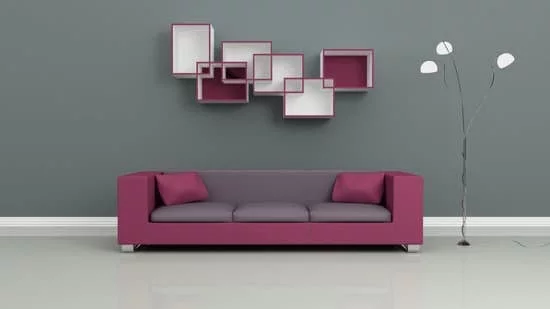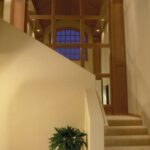Are you looking to add a touch of elegance and drama to your home decor? If so, then you might want to consider the Gothic Revival style. In this article, we’ll explore how to decorate your home in Gothic Revival, from understanding its key elements to selecting the right color palette and incorporating architectural and design features.
Gothic Revival style is a timeless and elegant aesthetic that draws inspiration from the medieval period. It is characterized by its dramatic and ornate decorative elements, pointed arches, and intricate tracery. By understanding the key elements of this style, you can create a truly unique and stunning look for your home.
When it comes to choosing the right color palette for a Gothic Revival home, rich and deep colors such as burgundy, deep purple, forest green, and navy blue are often used to evoke a sense of luxury and opulence. These colors can be complemented with metallic accents such as gold or silver to add an extra touch of glamour to the space.
In addition to color selection, furniture and decor play a crucial role in achieving the Gothic Revival look. Ornate and intricately carved furniture pieces, along with luxurious textiles such as velvet and brocade, can help bring this style to life in your home. Whether you’re interested in revamping your entire interior or just adding subtle touches of Gothic Revival flair to your existing decor, there are plenty of options available for every budget.
Understanding the Key Elements of Gothic Revival Home Decor
Gothic Revival home decor is a style that draws inspiration from the architectural and design elements of the medieval Gothic period. This style was popular in the 19th century and has made a comeback in modern interior design due to its dramatic and timeless appeal. Understanding the key elements of Gothic Revival home decor is essential for creating an authentic and visually stunning living space.
Key Elements of Gothic Revival Home Decor:
1. Pointed arches: The pointed arch is a trademark feature of Gothic architecture and is often incorporated into doorways, windows, and even furniture design in Gothic Revival homes.
2. Ornate tracery: Tracery refers to the intricate stone or woodwork seen in stained glass windows, screens, and decorative panels. These elaborate patterns are a defining characteristic of Gothic Revival decor.
3. Vaulted ceilings: High vaulted ceilings with exposed wooden beams are reminiscent of Gothic cathedrals and can add a sense of grandeur to a room.
4. Gargoyles and grotesques: These sculptural elements were commonly used as decorative accents on buildings during the Gothic period and can be incorporated into home decor as unique focal points.
5. Use of natural materials: Wood, stone, and wrought iron are often used in Gothic Revival decor to create a sense of authenticity and timelessness.
Incorporating these key elements into your home decor will help you achieve an unmistakably Gothic Revival style that exudes elegance and sophistication while paying homage to history and tradition. Whether you live in a historic home or simply want to achieve this distinctive aesthetic, understanding these fundamental elements is crucial for creating a captivating space that captures the essence of Gothic Revival design.
Choosing the Right Color Palette for a Gothic Revival Home
Gothic Revival style is all about creating a sense of drama and grandeur, and choosing the right color palette is essential in achieving this aesthetic in your home. When it comes to decorating your home in Gothic Revival style, it’s important to select colors that evoke a sense of mystery, elegance, and opulence. Deep, rich hues such as deep reds, purples, and blues are often used in Gothic Revival decor to create a sense of drama and richness.
In addition to these bold colors, black is also a key component of the Gothic Revival color palette. Black can be used for trim, accents, or even as a main color for walls or furniture. It adds a sense of depth and darkness that is characteristic of the Gothic Revival style.
When incorporating the right color palette into your Gothic Revival home decor, it’s important to consider the overall mood you want to achieve. Lighter shades such as soft grays and muted blues can be used to balance out the darker colors and bring a sense of sophistication to the space.
Finally, don’t be afraid to experiment with metallic accents such as gold or silver. These glamorous touches can add an extra layer of luxury to your Gothic Revival decor.
| Key Color Palette Elements for Gothic Revival Style | Description |
|---|---|
| Deep, rich hues | Colors like deep reds, purples, and blues create a sense of drama and richness |
| Black as a key component | Adds depth and darkness characteristic of Gothic Revival style |
| Metallic accents | Glamorous touches such as gold or silver add extra luxury |
Furniture and Décor Selection Tips for a Gothic Revival Home
When it comes to decorating a home in the Gothic Revival style, choosing the right furniture and décor is essential to achieving the desired look. One of the key elements of this style is the use of ornate and dramatic furniture pieces that evoke the grandeur of medieval castles and churches. To achieve this look, consider incorporating heavy, dark wood furniture with intricate carvings and detailing.
In addition to furniture, decorative items are also crucial in completing the Gothic Revival aesthetic. Look for items such as wrought iron candle holders, stained glass panels, and intricate tapestries to add texture and visual interest to your space. These decorative elements will help create a sense of drama and elegance that is characteristic of Gothic Revival design.
When selecting furniture and décor for a Gothic Revival home, it’s important to prioritize authenticity. Opt for antique or vintage pieces whenever possible to maintain the historical integrity of the style. Additionally, consider sourcing items from specialty stores or online retailers that specialize in Gothic Revival furniture and décor.
To truly capture the essence of Gothic Revival design in your home, pay attention to details such as upholstery fabric, hardware finishes, and embellishments. These small touches can make a big difference in creating an authentic and visually stunning space.
| Tips for Furniture Selection | Tips for Dcor Selection |
|---|---|
| Choose heavy, dark wood furniture with intricate carvings | Incorporate wrought iron candle holders and stained glass panels |
| Prioritize authenticity by opting for antique or vintage pieces | Source items from specialty stores that specialize in Gothic Revival dcor |
| Pay attention to upholstery fabric, hardware finishes, and embellishments | Select items such as tapestries to add texture and visual interest |
Incorporating Gothic Revival Architecture and Design Into Your Home
Gothic Revival architecture and design are known for their intricate details, pointed arches, and ornate decorations. If you’re looking to bring the timeless elegance of Gothic Revival style into your home, there are several key elements to consider. From architectural features to decorative accents, here’s how to incorporate Gothic Revival architecture and design into your home:
1. Pointed Arches: One of the signature elements of Gothic Revival architecture is the use of pointed arches. Consider incorporating these arches into doorways, windows, and even built-in shelving units. These arches add a sense of grandeur and verticality to any space.
2. Decorative Tracery: Tracery is another hallmark of Gothic Revival design. Look for opportunities to include tracery patterns in features like stained glass windows or decorative screens. These intricate patterns add a touch of Gothic charm to any room.
3. Vaulted Ceilings: If you’re renovating or building a new home, consider adding vaulted ceilings to capture the grandeur of traditional Gothic architecture. Not only do vaulted ceilings create a sense of spaciousness, but they also provide an opportunity to showcase ornate ceiling details such as moldings or rosettes.
By incorporating these architectural elements into your home, you can create a truly stunning homage to the Gothic Revival style.
Creating a Focal Point With Gothic Revival Style
When decorating your home in the Gothic Revival style, creating a focal point is essential to capturing the essence of this architectural and design movement. Whether it’s a structural feature or a decorative element, Gothic Revival style emphasizes the use of focal points to draw attention and create visual interest in a space. One way to achieve this is by incorporating ornate tracery patterns, pointed arches, and intricate detailing into your home’s architecture or decor.
To create a focal point with Gothic Revival style, consider incorporating a grand fireplace with carved stone mantle and intricate tracery details. This can serve as a stunning focal point in your living room or dining area, adding an elegant touch while staying true to the Gothic Revival aesthetic.
Additionally, large windows with pointed arches and tracery patterns can also serve as striking focal points, allowing natural light to filter through and illuminate the space while showcasing the architectural beauty of the Gothic Revival style.
Incorporating statement furniture pieces with ornate carvings and architectural details can also help create a focal point in your home. Look for pieces such as intricately carved bed frames, chairs with pointed arches, or ornate cabinets and console tables to add drama and visual interest to your interior design.
These pieces can command attention and become the centerpiece of a room when adorned with rich fabrics or elaborate accessories that complement the Gothic Revival style. By focusing on creating striking visual elements within your home, you can effectively capture the essence of Gothic Revival style and bring timeless elegance into your living space.
Lighting and Accessories for a Gothic Revival Home
When it comes to decorating a home in the Gothic Revival style, lighting and accessories play a crucial role in creating the desired ambiance. From dramatic chandeliers to intricate accessories, every detail can contribute to the overall aesthetic of a Gothic Revival home.
Choosing the Right Lighting Fixtures
In a Gothic Revival home, lighting fixtures should be grand and ornate. Look for chandeliers with elaborate designs featuring motifs such as ornate tracery, pointed arches, and intricate carvings. Opt for fixtures made of dark metals or wrought iron to maintain the gothic aesthetic. Wall sconces with stained glass shades can also add a touch of medieval charm to your space.
Selecting Accessories With Gothic Revival Style
Accessories are an essential part of completing the Gothic Revival look in your home. Consider adding decorative elements such as tapestries, intricately carved wooden furniture, and ornate mirrors with gothic-inspired frames. Look for items that feature details like quatrefoils, trefoils, and other classic gothic motifs to enhance the atmosphere of your space.
Incorporating Stained Glass
Stained glass windows or decorative panels are iconic elements of Gothic Revival architecture and design. Incorporating stained glass into your home can add a sense of drama and color. Consider installing stained glass windows or adding smaller stained glass pieces as decorative accents throughout your space.
By carefully selecting lighting fixtures and accessories that embrace the characteristics of Gothic Revival design, you can bring an air of historic elegance to your home. These elements help create a cohesive and immersive environment that reflects the timeless beauty of this distinctive style.
Maintaining the Authenticity of Gothic Revival Style in Your Home
When decorating your home in gothic revival style, it is essential to maintain the authenticity of this unique and captivating design aesthetic. Embracing the timeless elegance of gothic revival decor means paying attention to the details and ensuring that every aspect of your home reflects the beauty and grandeur of this historical style.
One key element in maintaining the authenticity of gothic revival style is to pay homage to the architectural elements that define this design aesthetic. Incorporating pointed arches, ribbed vaults, and flying buttresses into your home’s architecture can create a truly authentic gothic revival look. Additionally, adding ornate tracery and quatrefoils to windows and doorways can further enhance the authenticity of this style.
In addition to architectural elements, attention to detail in furniture and decor selection is crucial for maintaining the authenticity of gothic revival style in your home. Look for pieces with intricate carvings, ornate patterns, and dark, rich woods to capture the essence of this historical period. Furniture with exaggerated proportions and dramatic silhouettes can also add an authentic touch to your gothic revival interior.
When selecting lighting and accessories for a gothic revival home, opt for fixtures and decorative accents that exude a sense of drama and mystery. Dark metal sconces, candlelight chandeliers, and stained glass windows can all contribute to creating an authentic gothic atmosphere in your home. Paying attention to these details will ensure that you stay true to the timeless elegance of gothic revival decor while creating a truly captivating living space.
Conclusion
In conclusion, embracing the timeless elegance of Gothic Revival decor involves understanding the key elements of this unique style and incorporating them into your home with careful attention to detail. By choosing the right color palette, selecting furniture and decor that align with the Gothic Revival aesthetic, and integrating architectural elements into your space, you can create a truly stunning homage to this historic design movement.
When decorating your home in Gothic Revival style, it’s important to remember that authenticity is key. While adding modern touches and personal flair is encouraged, maintaining the integrity of Gothic Revival decor will ensure a cohesive and impactful look. From creating a focal point with ornate details to selecting lighting and accessories that complement the overall aesthetic, every aspect of your home should reflect the grandeur and drama of this iconic style.
In essence, learning how to decorate your home in Gothic Revival style is a journey into the past that allows you to bring the timeless elegance of this historic design movement into your modern living space. With careful consideration for each element mentioned in this article, you can create a home that exudes sophistication, drama, and an appreciation for the rich history of Gothic Revival decor.
Frequently Asked Questions
How Can I Make My House Look More Gothic?
You can make your house look more gothic by incorporating elements such as pointed arches, stained glass windows, and ornate carvings. Dark, moody color schemes and dramatic lighting can also add to the gothic aesthetic.
What Makes a House Gothic Revival?
A house is considered gothic revival if it incorporates architectural elements inspired by medieval Gothic design, such as pointed arches, steeply pitched roofs, and turrets or spires. These homes often have a sense of grandeur and drama.
What Are the Colors for Gothic Revival Houses?
The colors commonly used for gothic revival houses include dark, rich shades such as deep purple, forest green, and dark gray. These colors help create a sense of mystery and drama that is characteristic of the gothic style. Additionally, black accents are often used to enhance the gothic look of the exterior.

I’m thrilled to be your companion on this exciting journey through the world of home decor and design. With a passion for turning houses into homes and a keen eye for the finer details, I’m here to help you transform your living spaces into beautiful, functional, and meaningful havens.





